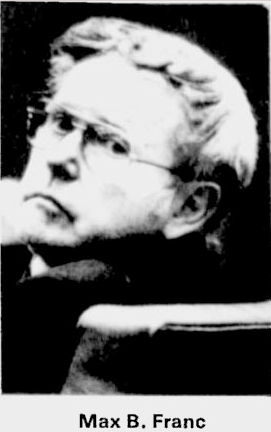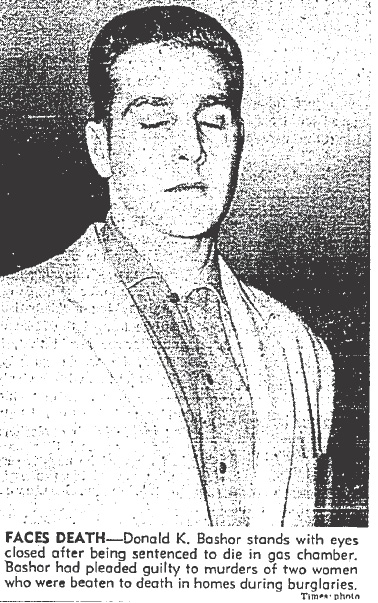 Donald Bashor, 27, confessed to dozens of local burglaries and to the bludgeon slayings of Karil Graham and Laura Lindsay. Under intense police questioning Donald didn’t admit to any further offenses, and as far as investigators could tell he’d revealed the extent of his crimes.
Donald Bashor, 27, confessed to dozens of local burglaries and to the bludgeon slayings of Karil Graham and Laura Lindsay. Under intense police questioning Donald didn’t admit to any further offenses, and as far as investigators could tell he’d revealed the extent of his crimes.
Deputy District Attorney Tom Finnerty issued a subpoena for Officer Donald C. Wesley, who had shot and wounded Bashor during his attempt to evade capture. Among the others called to appear before the grand jury were Detective Lieutenant Jack McCreadie, and autopsy surgeons Dr. Frederick Newbarr and Dr. Gerald K. Ridge.
Bashor was indicted on two counts of murder and two counts of burglary. The burglary charges stemmed from the looting of the apartment at 215 South Carondelet Street shared by Dorothy Cowan, Marcella Drews and Eunis Wingel. Lester E. Olson of 325 South Occidental Boulevard, was also burglarized by Bashor. Both crimes were committed about thirty minutes prior to the murder of Karil Graham.
The twenty-seven year-old killer pleaded not guilty by reason of insanity and his trial was set for August 14, 1956 in Judge Allen T. Lynch’s court. Because of the insanity plea Bashor would undergo examination by alienists for the State and the defense before the trial.
There are often delays in murder trials and Bashor’s was no exception, it didn’t get underway until October 4, 1956. The four alienists who examined Bashor deterined that he was sane when he committed the murders.
With the ultimate penalty on the table it was going to be a tough trial. But before the jury could be sworn in the defendant interrupted the proceedings to enter a guilty plea. Terrence Cooney, Bashor’s attorney, was as dumbfounded by his client’s move as was everyone else in the courtroom. Cooney didn’t want any part of placing a banana peel between his client and the gas chamber so he refused to go forward. Bashor fired him.
With Cooney still standing next to Bashor, Superior Judge Allen T. Lynch explained to the defendant that the law prohibits acceptance of a guilty plea in a capital case without benefit of counsel. Cooney must have decided to bend to his client’s will because Judge Lynch accepted the guilty plea. Along with the plea, Judge Lynch also accepted responsibility for determining Bashor’s sentence.
On October 16, 1956, Judge Lynch was ready to pronounce sentence. The courtroom was quiet as the judge began to speak. “This is the most difficult duty I have ever had to perform. For the last four days I have been able to think of nothing else. These were cruel, brutal killings. I find no mitigating circumstances.”
According to newspaper reports Judge Lynch appeared to have difficulty speaking. He paused for several long beats and then continued. “On counts one and three (the two murders) the court sentences you to suffer the death penalty. May God have mercy on your soul!”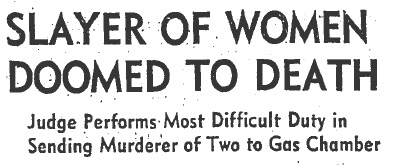
It took about a year for the California State Supreme Court to review the automatic appeal and affirm the death sentence in Bashor’s case.
On October 10, 1957, the night before his scheduled execution, Donald Bashor refused a last meal and then he slept from 1:05 a.m. to 7:05 a.m. When he awoke he had toast and coffee. He read a handful of letters he had recently received and then turned to the Bible.

Photograph by Edward Gamer / Los Angeles Times Senior Deputy George Coenen, left, and Sgt. Howard Earle, right, escort convicted killer Donald Keith Bashor on his trip to San Quentin, Oct. 25, 1956. Bashor’s story was the basis of a “Playhouse 90” episode by Jules Maitland. Bashor’s slaying of Graham also plays a prominent role in Jack Webb’s “The Badge,” a not terribly accurate book reissued in 2005.
Unlike many killers, Donald Bashor seemed genuinely remorseful for the murders. His last words were: “I’m glad my crimes are coming to an end. I am sorry I cannot undo the horrible things I did.”
Gas began to fill San Quentin’s death chamber at 10:03 a.m. and at 10:12 a.m. Donald Keith Bashor was pronounced dead.
EPILOGUE
There was something about Donald Keith Bashor that set him apart from many other killers. It may have been his movie star good looks, or it may have been the fact that he sought atonement for his crimes in the gas chamber. Whatever it was, Bashor’s story became an episode of the prime time TV series PLAYHOUSE 90 in 1958. Bashor was portrayed by Tab Hunter and the episode was narrated by former Los Angeles Mirror columnist Paul Coates. The highly rated episode was directed by Arthur Penn who would later direct such great films as The Miracle Worker and Bonnie & Clyde.
The episode was not without behind-the-scenes drama. One of the sponsors for the episode, entitled “Portrait Of A Murderer”, was the Southern California Gas Company. They wanted to eliminate Bashor’s trip to the gas chamber from the script. Producer Martin Manulis flatly refused and the episode aired as written.
Donald Bashor’s story also claimed the attention of ten-year-old James Ellroy. In 1958, his father gave him a copy of THE BADGE written by TV cop Jack Webb who portrayed Sgt. Joe Friday on DRAGNET. Bashor’s case is the first one covered in the book. In large part it was THE BADGE that inspired Ellroy to become a novelist. It definitely sparked his interest in Los Angeles crime. Now it’s time for a shameless plug — I was fortunate to work with James Ellroy, Glynn Martin, Megan Martin, Nathan Marsak, and Mike Fratatoni on the book LAPD ’53. The book project was one of the best experiences I’ve ever had.
EXTRA CREDIT
First, let me direct you to a clip from James Ellroy’s CITY OF DEMONS (2011) in which he glibly recounts the Bashor case.
https://youtu.be/-uhSmgyBn0Q?list=PLzxB58NXklh9DlnIfP0RI70tsjZB8-Gr2
Next, a far more serious scene from the PLAYHOUSE 90 production of PORTRAIT OF A MURDERER
https://youtu.be/9bsEW39v1JI

 The hunt for Bashor was on. The twenty-seven year-old man was discovered by LAPD officers and detectives as he prowled the alley between two apartment buildings at
The hunt for Bashor was on. The twenty-seven year-old man was discovered by LAPD officers and detectives as he prowled the alley between two apartment buildings at  Bashor could refuse the lie detector test but the palm print was damning. Ironically, it was Officer McLaughlin who had been Bashor’s nemesis in 1949 when he was sent up the first time on a burglarly conviction.
Bashor could refuse the lie detector test but the palm print was damning. Ironically, it was Officer McLaughlin who had been Bashor’s nemesis in 1949 when he was sent up the first time on a burglarly conviction.
 According to Bashor he entered the residences of the women intending only to steal, but then why was he armed with an 18-inch length of lead pipe when he broke into Karil’s apartment? Bashor said that he had been ransacking the place when Karil awakened and began to scream. He hit her on the head and he continued to beat her until she went still. He didn’t bolt and run after the murder, he stayed and searched until he found Karil’s purse. He found $20. The next day he took the weapon and his bloody clothing and dropped it off the pier at Ocean Park.
According to Bashor he entered the residences of the women intending only to steal, but then why was he armed with an 18-inch length of lead pipe when he broke into Karil’s apartment? Bashor said that he had been ransacking the place when Karil awakened and began to scream. He hit her on the head and he continued to beat her until she went still. He didn’t bolt and run after the murder, he stayed and searched until he found Karil’s purse. He found $20. The next day he took the weapon and his bloody clothing and dropped it off the pier at Ocean Park.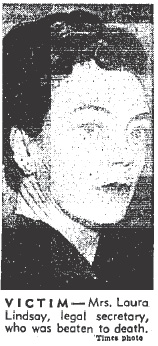 On May 25, 1956 the Los Angeles Times reported that there had been another murder the night before. The circumstances were very similar to Karil Graham’s slaying and it was in the same general neighborhood. The victim was Laura Lindsay, a 62-year-old legal secretary. Her home at
On May 25, 1956 the Los Angeles Times reported that there had been another murder the night before. The circumstances were very similar to Karil Graham’s slaying and it was in the same general neighborhood. The victim was Laura Lindsay, a 62-year-old legal secretary. Her home at 
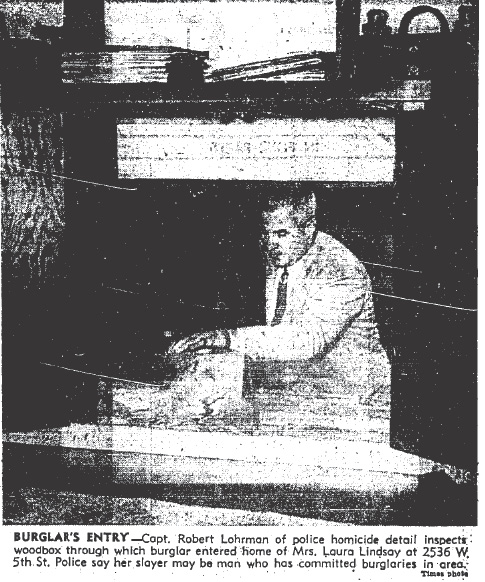
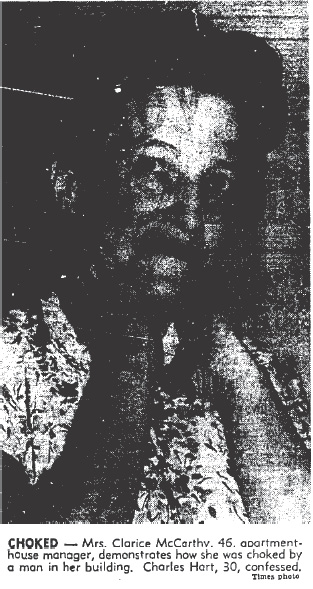
 LAPD Motorcycle Officer Robert Knight found the suspect in the vicinity of Clarice’s apartment shortly after the attack. Detectives Jack McCreadie and S.W. Beckner of the central homicide squad said that the attacker, identified as 30-year-old Charles Hart of
LAPD Motorcycle Officer Robert Knight found the suspect in the vicinity of Clarice’s apartment shortly after the attack. Detectives Jack McCreadie and S.W. Beckner of the central homicide squad said that the attacker, identified as 30-year-old Charles Hart of  The records search turned up the names of three possible suspects; although only one of them, a 37-year-old ex-con named Clifford Russell Pridemore, was arrested. LAPD picked him up near
The records search turned up the names of three possible suspects; although only one of them, a 37-year-old ex-con named Clifford Russell Pridemore, was arrested. LAPD picked him up near 
 A couple of weeks following Karil Graham’s murder police announced they were investigating the slugging of Emily Jones, 26, a local dance hall hostess. Jones had awakened in her apartment at
A couple of weeks following Karil Graham’s murder police announced they were investigating the slugging of Emily Jones, 26, a local dance hall hostess. Jones had awakened in her apartment at 
 Karil Graham, an attractive divorcee in her late 30s, had always wanted to be an artist. She studied fine art in New York, but eventually she realized that she didn’t possess the natural talent to have a successful career. Unwilling to completely give up on her dream, Karil found a great way to be involved in what she loved most–she became the registrar at Art Center School, 5353 West 3rd Street. She spent much of her working day counseling budding artists, and the rest of her time in the company of talented faculty members. Karil had a warm smile that lit up her face. She was so well liked by the students that she was thought of as their “mother confessor”.
Karil Graham, an attractive divorcee in her late 30s, had always wanted to be an artist. She studied fine art in New York, but eventually she realized that she didn’t possess the natural talent to have a successful career. Unwilling to completely give up on her dream, Karil found a great way to be involved in what she loved most–she became the registrar at Art Center School, 5353 West 3rd Street. She spent much of her working day counseling budding artists, and the rest of her time in the company of talented faculty members. Karil had a warm smile that lit up her face. She was so well liked by the students that she was thought of as their “mother confessor”.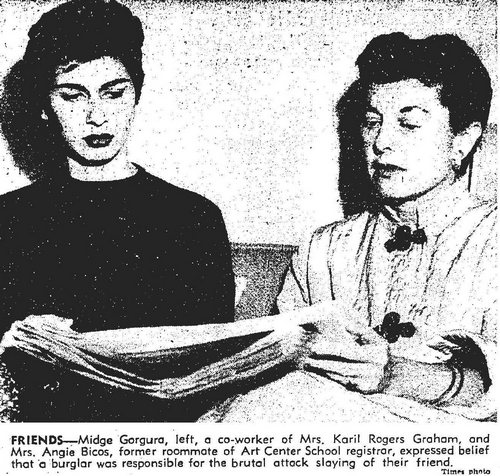 Karil had a midnight snack and then prepared to go to bed. She removed her makeup, slipped into her nightgown and put her hair up in curlers. Then she turned on the electric blanket and got into bed.
Karil had a midnight snack and then prepared to go to bed. She removed her makeup, slipped into her nightgown and put her hair up in curlers. Then she turned on the electric blanket and got into bed.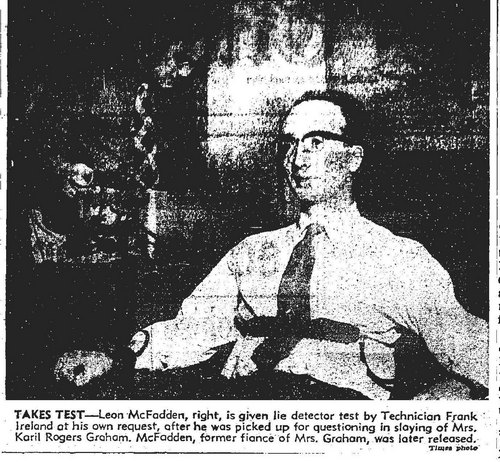 Los Angeles Police Department homicide detectives, Jack McCreadie and Charles Detrich, arrived and tried to make sense of the scene. Karil had sustained at least two devastating wounds to her head, but no weapon was found. During their examination of the crime scene they discovered a bloody fingerprint on the inside of the front doorknob. The knob was removed and sent to the crime lab, along with human hair found under one of Karil’s fingernails.
Los Angeles Police Department homicide detectives, Jack McCreadie and Charles Detrich, arrived and tried to make sense of the scene. Karil had sustained at least two devastating wounds to her head, but no weapon was found. During their examination of the crime scene they discovered a bloody fingerprint on the inside of the front doorknob. The knob was removed and sent to the crime lab, along with human hair found under one of Karil’s fingernails.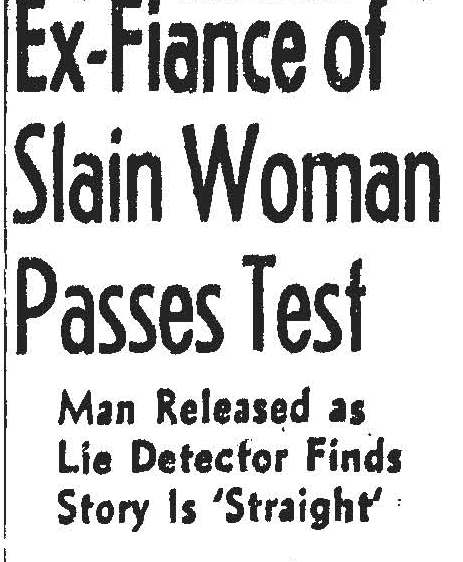
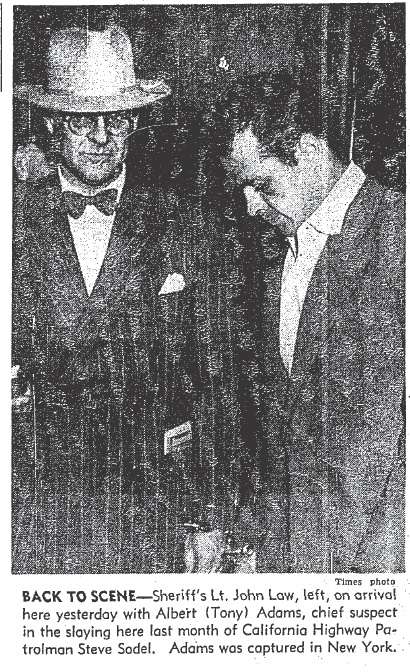 On October 24, 1946, Tony Adams limped into Judge Leroy Dawson’s courtroom and was formally charged with the murder of California Highway Patrolman Steve Sodel. He was also indicted for grand theft of the Chevy sedan which belonged to Jeanne Trude. Adams was manacled to Lieutenant John Law of the sheriff’s department, presumably to prevent him from making another escape attempt. Adams’ attorney, William E. Turner, waived reading of the complaint and Judge Dawson set a hearing date.
On October 24, 1946, Tony Adams limped into Judge Leroy Dawson’s courtroom and was formally charged with the murder of California Highway Patrolman Steve Sodel. He was also indicted for grand theft of the Chevy sedan which belonged to Jeanne Trude. Adams was manacled to Lieutenant John Law of the sheriff’s department, presumably to prevent him from making another escape attempt. Adams’ attorney, William E. Turner, waived reading of the complaint and Judge Dawson set a hearing date.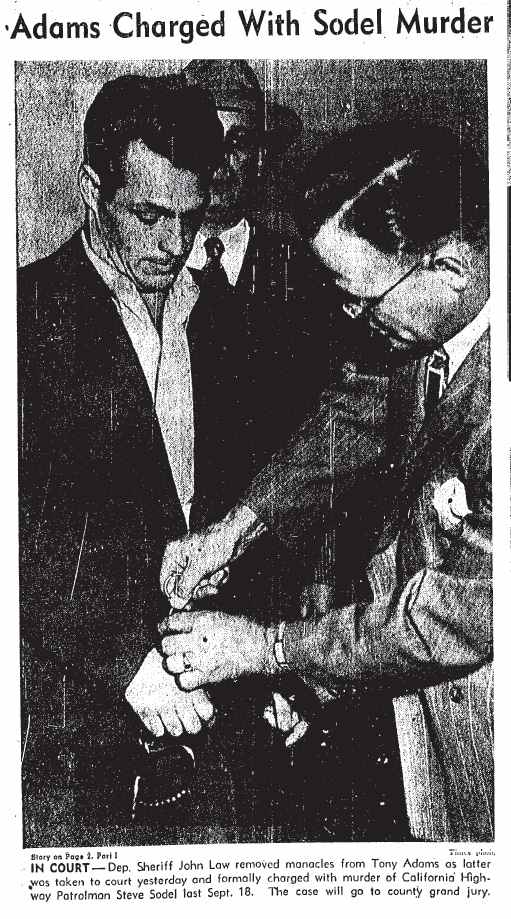
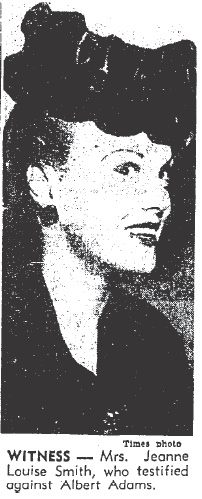

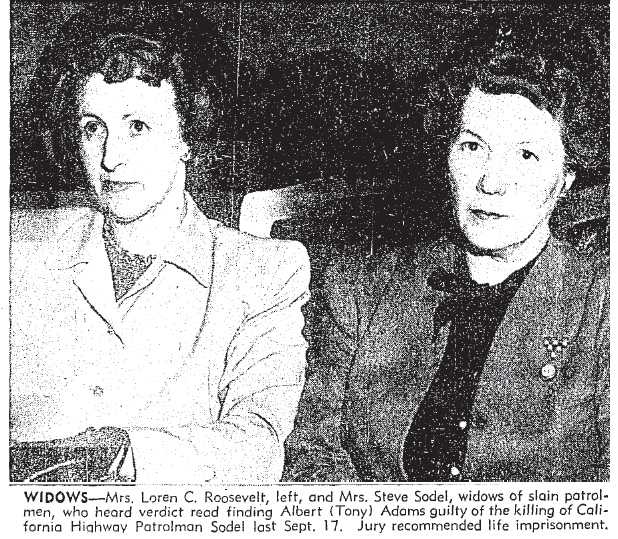
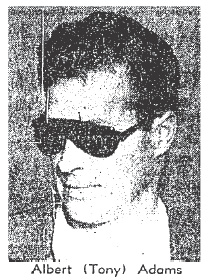
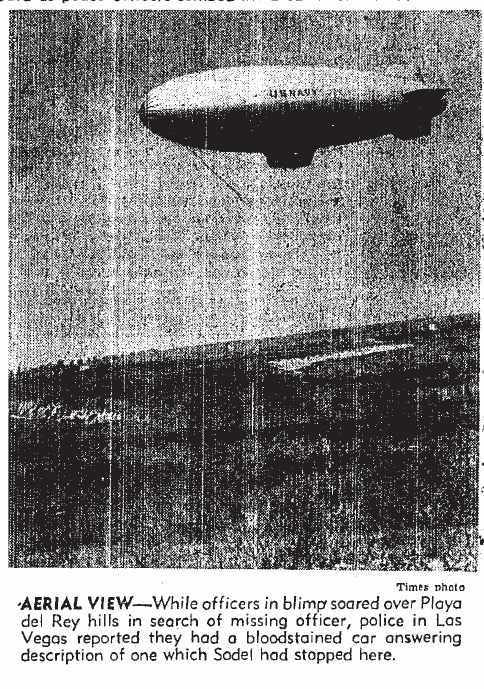 Equipped with binoculars, the observers aboard a Navy blimp piloted by Lt. A. J. Slack skimmed the treetops of Palos Verdes, Playa del Rey, Hollywood Hills and Topanga Canyon searching for any sign of missing CHP Patrolman Steve Sodel. The terrain yielded nothing.
Equipped with binoculars, the observers aboard a Navy blimp piloted by Lt. A. J. Slack skimmed the treetops of Palos Verdes, Playa del Rey, Hollywood Hills and Topanga Canyon searching for any sign of missing CHP Patrolman Steve Sodel. The terrain yielded nothing.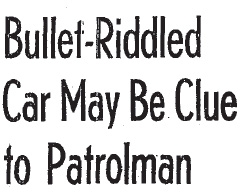 Late on the fourth day of the search a bloodstained sedan, riddled with bullet holes, was found abandoned near Las Vegas, Nevada. A private plane owned by a member of the Los Angeles County Sheriff’s Aero Bureau flew members of the CHP and the Sheriff’s department to the scene.
Late on the fourth day of the search a bloodstained sedan, riddled with bullet holes, was found abandoned near Las Vegas, Nevada. A private plane owned by a member of the Los Angeles County Sheriff’s Aero Bureau flew members of the CHP and the Sheriff’s department to the scene.
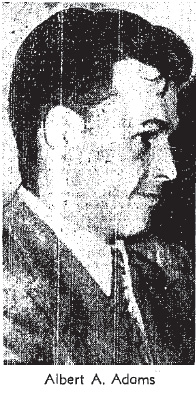
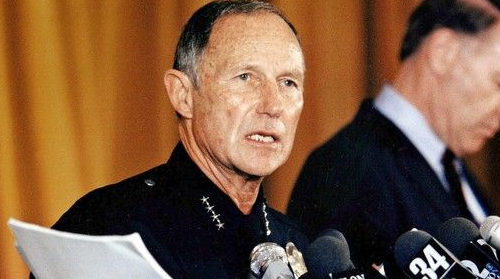
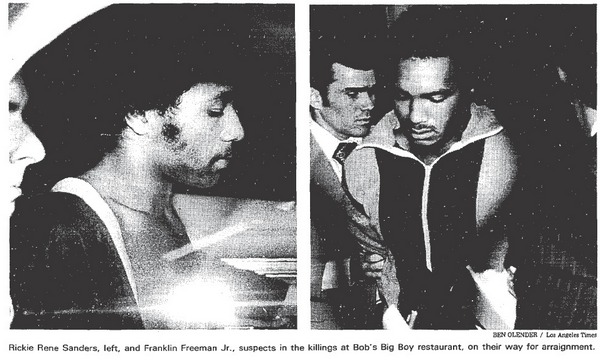

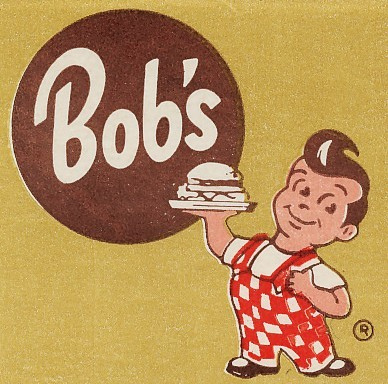 It was 2:05 a.m. on Sunday, December 14, 1980 and the Bob’s Big Boy restaurant on La Cienega near Sawyer, just north of the Santa Monica Freeway, was closed for the night. There were still eleven people inside, two customers preparing to leave, and nine employees.
It was 2:05 a.m. on Sunday, December 14, 1980 and the Bob’s Big Boy restaurant on La Cienega near Sawyer, just north of the Santa Monica Freeway, was closed for the night. There were still eleven people inside, two customers preparing to leave, and nine employees.


